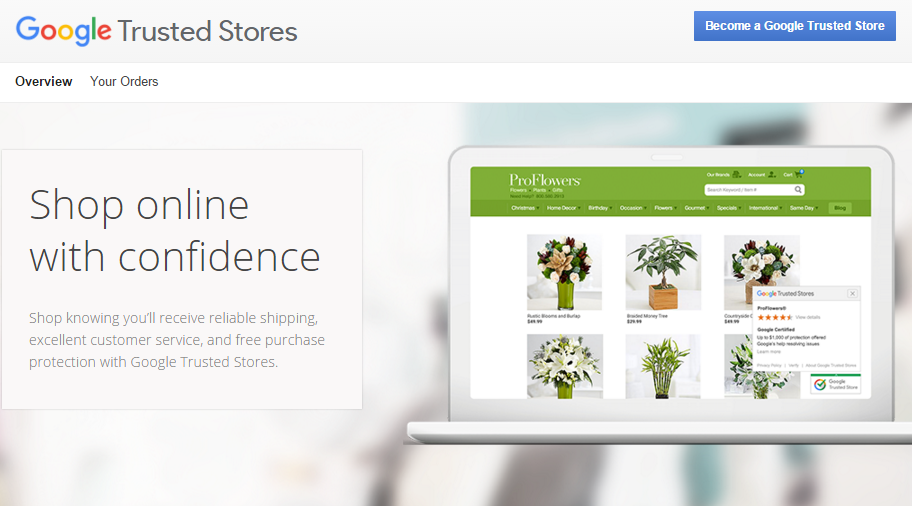
Google Trusted Stores, launched in 2012, lends Google’s credibility to online merchants who qualify.
January 26, 2016: E-tailers and merchants of every stripe know the value of online reviews, via Yelp, TripAdvisor, or numerous online review aggregators.
Reviews — provided they are honest, and come from real people — are a form of personal witnessing that can cut through commercial puffery. Consumers considering whether to buy the same product from online merchant A or B may be swayed to purchase from B if consumer reviews are more favorable. Consequently, online merchants have a lot to gain — and lose — from them.
Google recently launched a program called Google Trusted Stores (GTS) that leverages reviews — along with $1,000 protection for online buyers — in a bid to provide merchants with added credibility. If you’re an online merchant seeking to burnish your credentials, the program may have tangible advantages.
Making the Grade
Many merchants will be able to clear the basic GTS hurdles. But to maintain good standing in the program, merchants will need to do much more.
1. Average monthly order volume greater than 200 per online store.
2. No restricted products, including weapons, nutritional supplements, tobacco, and some pharmaceuticals. A complete list of prohibited products is available at: https://support.google.com/trustedstores/answer/1687195?hl=en&ref_topic=4544281
3. The capability of internal staff to effectively respond to customer complaints/issues within a 24 hour period.
4. An HTTPs (secure) shopping cart system.
5. A shopping cart system hosted on the same domain as the online store.
Many merchants will be able to clear these hurdles. But to maintain good standing in the program, merchants must do much more, including:
1. Ship at least 80 percent of orders “on time” as reported by Trusted Store’s customer survey system.
2. Maintain at least a 4.0 rating on customer surveys.
3. Have no more than 1 customer take advantage of Google’s purchase protection plan within any single 90-day period.
4. Have no more than $5,000 of purchase protection funds disbursed within any rolling 1-year period.
Major Benefits
Provided that the merchant is doing a good CRM job, the benefits that will flow to the merchant from successful participation in GTS manifest themselves in several ways, including:
1. The ability to display the Google Trusted Stores badge on the merchant’s site. This badge is typically displayed at the bottom of the site but can be displayed anywhere, including as a persistent element that remains visible as the user scrolls.
Google Trusted Stores Badge: The badge, when expanded, links to a GTS Validation page for the merchant.
The badge, when expanded via the “verify” link, expands into a verification page unique to each merchant.
2. Quicker generation of online reviews through the online customer survey mechanism. Timely reviews are vital given that a merchant’s performance can vary widely over time. In the screenshot below, you can see that the displayed reviews are current and frequent, a good indication of consumer satisfaction.
The Google Trusted Stores merchant reviews page. Note that reviews on this page are current and frequent, enhancing merchant credibility.
3. The ability to take advantage of Adwords’ Review Extensions, which let a merchant display ratings in PPC ads. In the screenshot below, the red areas show how these extensions change the look of PPC ads by adding the words “Excellent Shopping Experience — Google Trusted Stores” in the main area and a checkbox for ads appearing in the right rail of the SERP.
Adwords Review Extensions (highlighted in red) distinguish PPC ads from those from non-participating merchants.
Pros and (very few) cons of joining GTS
According to Google, PPC ads with Review Extensions can boost CTR rates by up to 10 percent.
Provided that a merchant can meet the eligibility requirements and maintain a high level of service, there are no real disadvantages to joining GTS, especially since Google has dropped its original requirements that merchants furnish it with shipment and order cancellation feeds (merchants traditionally regard such information as proprietary and bridle at furnishing it to any 3rd parties).
GTS technical implementation remains extremely easy (inserting two lines of code on the merchant’s site suffices to integrate it with GTS); the only wrinkle we observed is the fact that the GTS badge is sometimes blocked by tracker-blockers such as Privacy Badger (although it doesn’t appear to be blocked by popular ad blocker AdBlock Plus).
Beyond this, the merchant must include what Google calls an “order implementation module” on the merchant’s order confirmation page. A handy implementation guide is available at the following page: https://support.google.com/trustedstoresmerchant/answer/6063087
Once technical integration is finalized, the merchant’s store will enter a qualification period for a minimum of 30 days while Google collects data and assesses eligibility to participate in GTS. Once accepted (or rejected), Google will directly notify the applicant via e-mail.
- 10 Mistakes to Avoid When Using QR Codes for Marketing - September 20, 2023
- Kevin Lee on How AI Changes the SEO Landscape - August 31, 2023
- The Power of Compound Marketing: Kevin Lee Presents @ 1MediaWorld 2023 Global Conference - March 7, 2023
